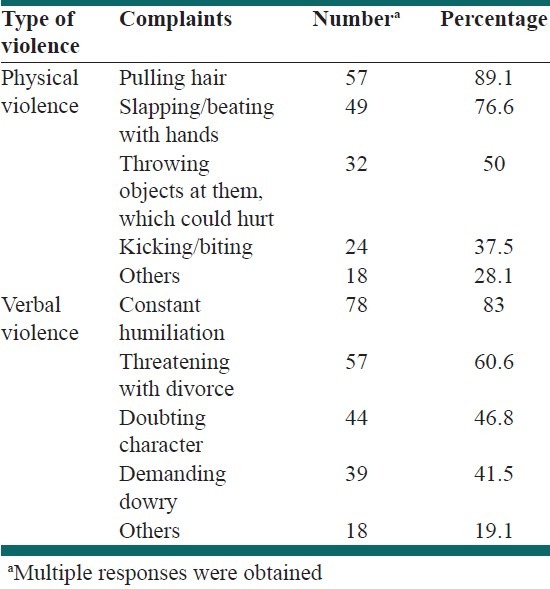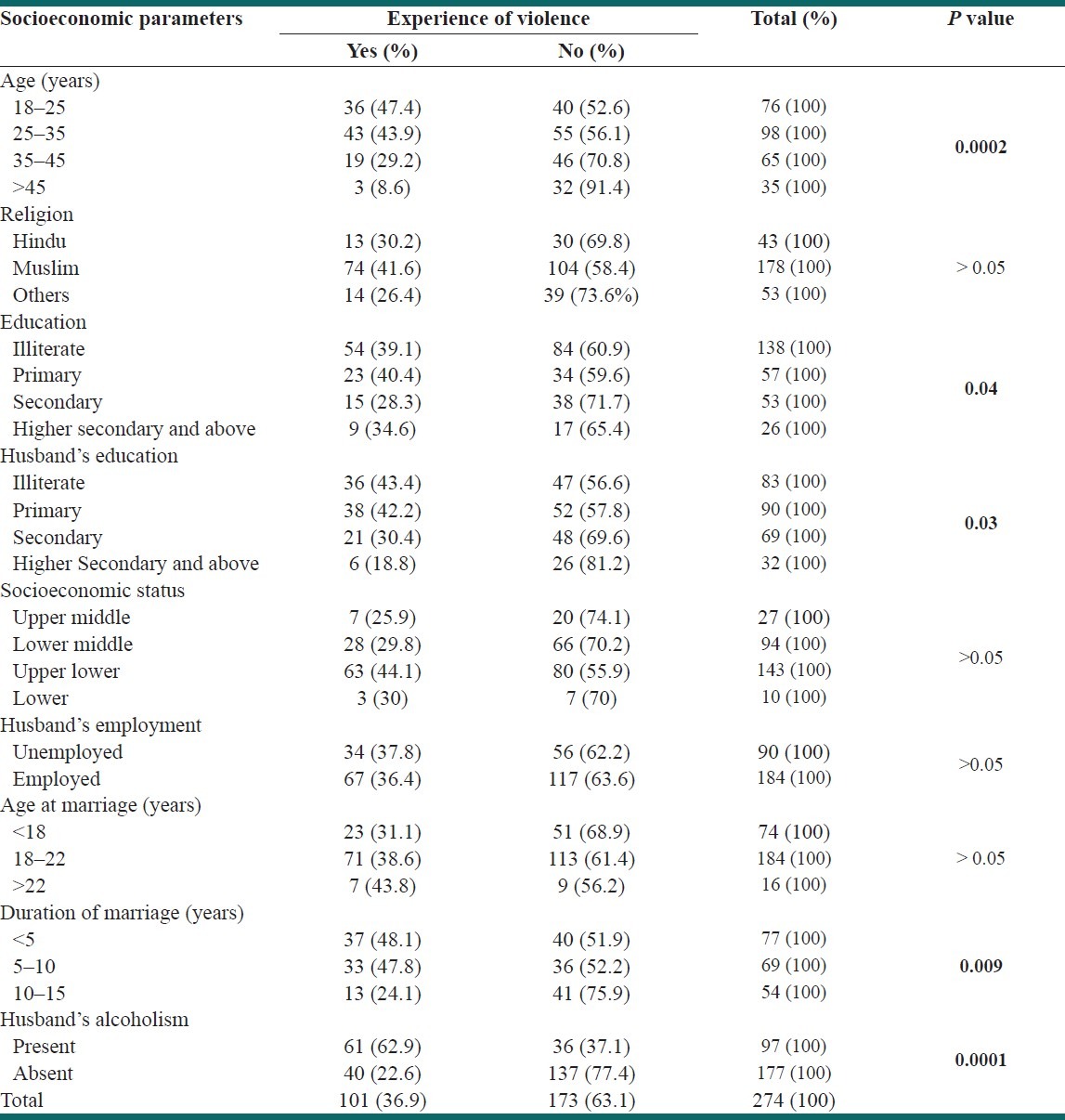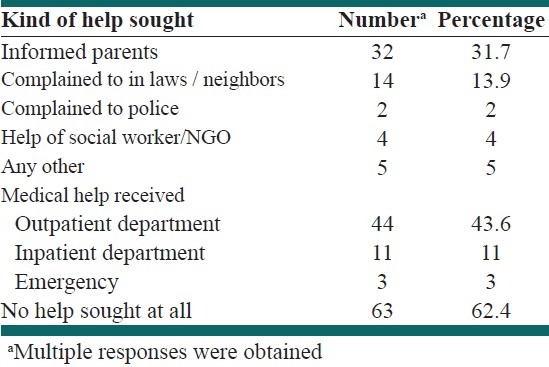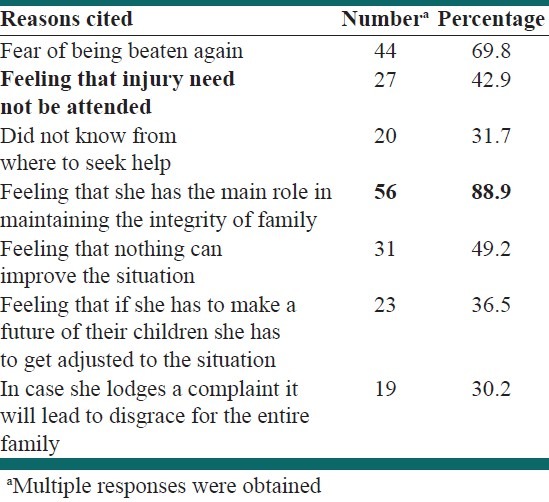Abstract
Background:
Gender-based violence is recognized as a major issue on international human rights agenda. Domestic violence and abuse can happen to anyone, yet the problem is often overlooked, excused, or denied. This is especially true when abuse is psychological, rather than physical.
Methods:
A community-based cross-sectional study of 6 months duration was undertaken with the objective of studying the proportion and different forms of domestic violence, factors influencing it, and to study treatment-seeking behavior of these women. The study participants were married women in the age group 18–45 years residing in an urban slum area of Malwani, Mumbai. Using stratified random sampling, 274 subjects were selected. House to house visits were paid and they were interviewed face to face using a pretested semi-structured questionnaire after obtaining their informed consent. Rapport was established with the help of a Medical Social Worker. The questionnaire included information pertaining to the sociodemographic parameters and experience of domestic violence in the last 1 year and their treatment-seeking behavior for the same. Utmost care was taken to maintain privacy and confidentiality. Analysis was done using SPSS version 17.
Results:
The proportion of domestic violence was 36.9%. The most common form of violence was verbal in 87 (86.1%) followed by physical in 64 (63.4%).
Conclusion:
A significant association was found between domestic violence and age, education, spousal alcoholism, and duration of marriage.
Keywords: Community-based study, domestic violence, spouse, treatment-seeking behavior
INTRODUCTION
Gender-based violence is recognized as a major issue on international human rights agenda. Domestic violence and abuse can happen to anyone, yet the problem is often overlooked, excused, or denied. This is especially true when the abuse is psychological, rather than physical. The women may not want to divulge the confidential matter for reasons of shame, fear, guilt, or simply because they do not want to be disloyal to their partners—mainly in India. Hence, there is a serious gap in public health policy making and lack of appropriate programs. A review of over 50 population-based studies from 30 countries has reported the lifetime prevalence of intimate partner violence (IPV) to be between 10% and 52%.[1] In a retrospective cohort study conducted by telephone survey in the United States, about 14.7% reported IPV of any type in the previous 5 years, of whom 45.1% of abused women experienced more than 1 type of IPV.[2] As per the Bureau of Justice Statistics released by the US Department of Justice, the rate of intimate partner victimizations for females was 4.3 victimizations per 1000 females 12 years or older.[3] The lifetime prevalence of physical assault and sexual coercion was found to be 34% and 4%, respectively, in a rural country of western China.[4] The WHO multicountry study on Domestic Violence (DV) estimated that the lifetime prevalence of physical IPV varied from 13% (Japan) to 61% (Peru) with the current prevalence of IPV varying between 20% and 33%.[5] States have a duty to exercise due diligence to identify, prosecute, and prevent DV, and the estimate of the magnitude of the problem is an essential prerequisite. According to Indian National Family Health Survey – 3, in Maharashtra, 31% of ever-married women have experienced spousal physical or sexual violence from their current husband.[6] Almost one in three ever-married women have experienced spousal physical or sexual violence in Maharashtra—a proportion that is higher than in 15 other Indian states, the highest being in Bihar, that is, 59%. Although DV has been a focus for research since 1970s there has been a scarcity of information on its prevalence and the underlying factors precipitating DV in the developing countries.[7] It has been shown that the focused studies on violence against women tend to give a higher and correct estimate of violence compared with health surveys (eg, NFHS) in which only a small number of questions on violence are asked. A need was therefore felt for a community-based study focused on spousal domestic violence to gather data that could improve the understanding of this vicious problem. The research was undertaken to study the proportion and different forms of domestic violence in married women by their husbands, sociodemographic factors influencing domestic violence, and treatment-seeking behavior of these women.
METHODS
A community-based cross-sectional study of 6 months duration was undertaken with the objective of studying the proportion and different forms of domestic violence, factors influencing it, and to study the treatment-seeking behavior of these women. Study participants were married women in the age group 18–45 years residing in an urban slum area of Malwani, Mumbai. Sample size was calculated using the formula 4pq/L2. Using P = 27, q = 73, and L = 20% of P, the sample size was calculated as 270.[8] Using stratified random sampling, 274 subjects were selected (total number of married women in the age group 18–45 years = 35,200 and to get the sample size of 270 as calculated above, sampling interval, k = 35,200/270 = 130. Hence every 130th woman was selected as a study subject). House-to-house visits were made and they were interviewed face to face using a pretested semi-structured questionnaire after obtaining their informed consent. Rapport was established with the help of MSW. A questionnaire was prepared using Hidden Hurt–Domestic violence information as a reference, and then a pilot study was carried out in the local settings and depending on the findings of the study, the questionnaire was modified.[9] The questionnaire included information pertaining to the sociodemographic parameters and experience of domestic violence in the last 1 year and their treatment-seeking behavior for the same. Utmost care was taken to maintain privacy and confidentiality. Analysis was done using SPSS version 17. The following operational definitions were used: Domestic violence—it is any violence perpetrated by intimate partners; Physical violence—it is any act intended to harm, injure, or inflict pain on women; Verbal violence—it is any behavior or lack of it by the husband intended to undermine the woman's self confidence or lead to a lowered or negative self-esteem. Sexual violence—it is any attempt by the husband to obtain sexual act using coercion.
RESULTS
Out of the 274 women interviewed, 101 (36.9%) women had experienced some type of domestic violence. Verbal violence was the most common form of domestic violence observed in 87 (86.1%) women followed by physical violence in 64 (63.4%) and sexual violence in 24 (23.8%). Table 1 shows that among the victims of physical violence, pulling hair was the most common complaint found in 57 (89.1%) women followed by slapping/beating with hands in 49 (76.6%). Among the victims of verbal violence, constant humiliation in 78 (83%), threatening with divorce in 57 (60.6%), dowry demands in 39 (41.5%) were the complaints commonly observed. Out of the 101 victims, 46 (45.5%) women had experienced at least 1 episode of domestic violence per week followed by 31 (30.7%) women who experienced at least 1 episode of domestic violence fortnightly. Table 2 depicts that experience of domestic violence was found to be significantly associated with young age of women, lower literacy status both of the woman and of her husband, less duration of marriage, and husband addicted to alcohol. No statistical significant association was observed between experiences of domestic violence vs religion, socioeconomic status of the family, or with the age at marriage of the study participants. Table 3 shows that no kind of help was sought by 63 (62.4%) women in response to domestic violence while only 2 (2%) women had complained to police, 14 (13.9%) women complained to their in laws or neighbors. Table 4 shows that 56 (88.9%) women did not seek any help only for the sake of maintaining family integrity, 44 (69.8%) for the fear of being beaten again, 31 (49.2%) women felt nothing would improve the situation.
Table 1.
Distribution of victimized women according to the type of violence

Table 2.
Socioeconomic parameters and experience of domestic violence

Table 3.
Kind of help sought against domestic violence (n=101)

Table 4.
Reasons for not seeking help (n=63)

DISCUSSION
In the present study, the proportion of domestic violence was found to be 36.9%. Verbal violence was found to be the most common form of domestic violence in 87 (86.1%) followed by physical violence in 64 (63.4%) and sexual violence among 24 (23.8%) subjects, while the prevalence of physical violence was found to be 26% in a study done by Jeyaseelan et al.[10] and it was 61.5% in a study by Ruikar et al.[11] In a study done in Canada, the overall prevalence of IPV in current or recent relationships was 14.6%, whereas emotional abuse was reported by 10.4%, threat of violence by 8.3%, and physical or sexual violence by 7.6% of the respondents.[12] Constant humiliation in 78 (83%) and threatening with divorce in 57 (60.6%) were the most common forms of verbal abuse, while pulling hair in 57 (89.1%) and slapping/beating with hands in 49 (76.6%) were the most common forms of physical abuse in the current study. Similar results were obtained by Jeyaseelan et al.[10] and Ruikar et al.[11] The prevalence was higher among 25- to 34-year-old women, and in the early years of marriage in our study. It was similar to a study done by Kamat et al.[13] A study by Vickerman and Margolin has confirmed reduced rates of physical aggression with the increasing duration of marriage as observed in this study.[8] It was also observed that higher level of education, for men as well as women, protects against domestic violence. Dowry-related demands were also found to be an important instigating factor for domestic violence in the present study. This was also evident from higher prevalence of domestic violence in early years of marriage. In a study done in Spain it was observed that women with primary school education or without studies (odds ratio [OR]: 3.63 [1.90–6.92]), with 3 or more children (OR: 3.51 [1.78–6.90]), and those who were separated or divorced (OR: 2.81 [1.89–4.97]) were most likely to experience IPV.[14] Significant association was found between experience of domestic violence and alcoholism in husband similar to that found in studies done by Krishnan.[15] and Jejeebhoy.[16] Also in a longitudinal study carried out in New Zealand it was estimated that alcohol use disorder accounted for approximately 4.6%–9.3% of the reported violent offending/victimization and IPV perpetration in the cohort.[17] In the present study, only 2 (2%) women had complained to police and only 4 (4%) sought help from NGOs, whereas in a survey surveillance study carried out in Belgium only 19.2% and as few as 6.6% of the victims of physical and sexual abuse, respectively, sought medical care by consulting a general practitioner, gynecologist, or an emergency department.[18] Maintaining the integrity of the family was the major factor associated with nonreporting of the matter and seeking help for the violence in the current study. Also, fear of being beaten again, if sought help, was a common reason for not seeking help. None of the respondents in the study reported an extramarital intimate relationship. Because the nature of the study was sensitive, the participants might not have come up with the entire truth.
CONCLUSION
Domestic violence is a pervasive medical–social problem. A social panacea in the form of awareness that IPV is condemnable under any circumstances, together with compulsory schooling for both men and women is likely to positively affect the societal attitude. This should be coupled with better social support system for aggrieved women who have to continue in the violent relationship just because of the financial dependence.
Footnotes
Source of Support: Nil
Conflict of Interest: None declared.
REFERENCES
- 1.Heise L, Ellsberg M, Gottenmoeller M. Population Reports, series L, No. 11. Baltimore: Johns Hopkins School of Public Health, Population Information Program; 1999. Ending violence against women. [Google Scholar]
- 2.Thompson RS, Bonomi AE, Anderson M, Reid RJ, Dimer JA, Carrell D, et al. Intimate partner violence: Prevalence, types, and chronicity in adult women. Am J Prev Med. 2006;30:447–57. doi: 10.1016/j.amepre.2006.01.016. [DOI] [PubMed] [Google Scholar]
- 3.U.S. Department of Justice, Office of Justice Programs, Bureau of Justice Statistics. 2009. Sep, [Last accessed on 2011 Oct 27]. Available from: http://www.bjs.gov/content/pub/ascii/fvv.txt .
- 4.Yanqiu G, Yan W, Lin A. Suicidal Ideation and the Prevalence of Intimate Partner Violence Against Women in Rural Western China. Violence Against Women. 2011;17:1299–312. doi: 10.1177/1077801211425217. [DOI] [PubMed] [Google Scholar]
- 5.Garcia-Moreno C, Jansen H, Ellsberg M, Heise L, Watts C. WHO multicountry study on women's health and domestic violence against women. Geneva: WHO; 2005. [Google Scholar]
- 6.National family health survey 3, India, 2005-06. Goa, Mumbai: IIPS; 2009. International Institute of Population Sciences and Macro International. [Google Scholar]
- 7.Koenig MA, Stephenson R, Ahmed S, Jejeebhoy SJ, Campbell J. Individual and Contextual Determinants of Domestic Violence in North India. Am J Public Health. 2006;96:132–8. doi: 10.2105/AJPH.2004.050872. [DOI] [PMC free article] [PubMed] [Google Scholar]
- 8.Vickerman KA, Margolin G. Trajectories of physical and emotional marital aggression in midlife couples. Violence Vict. 2008;23:18–34. doi: 10.1891/0886-6708.23.1.18. [DOI] [PMC free article] [PubMed] [Google Scholar]
- 9. [Last accessed date 2011 Sep 25]. Available from: http://www.hiddenhurt.co.uk/questionnaire.html .
- 10.Jeyaseelan L, Kumar S, Neelakantan N, Peedicayil A, Pillai R, Duvvury N. Physical spousal violence against women in India: Some risk factors. J Biosoc Sci. 2007;39:657–70. doi: 10.1017/S0021932007001836. [DOI] [PubMed] [Google Scholar]
- 11.Ruikar MM, Pratinidhi AK. Physical wife abuse in an urban slum of Pune, Maharashtra. Indian J Public Health. 2008;52:215–7. [PubMed] [Google Scholar]
- 12.Ahmad F, Hogg-Johnson S, Stewart DE, Levinson W. Violence involving intimate partners: Prevalence in Canadian family practice. Can Fam Physician. 2007;53:461–8. 460. [PMC free article] [PubMed] [Google Scholar]
- 13.Kamat U, Ferreira AM, Motghare DD, Kamat N, Pinto NR. A cross-sectional study of physical spousal violence against women in Goa. Healthline. 2010;1:34–40. [Google Scholar]
- 14.Vives-Cases C, Alvarez-Dardet C, Gil-González D, Torrubiano-Domínguez J, Rohlfs I, Escribà-Agüir V. Sociodemographic profile of women affected by intimate partner violence in Spain. Gac Sanit. 2009;23:410–4. doi: 10.1016/j.gaceta.2009.02.007. [DOI] [PubMed] [Google Scholar]
- 15.Krishnan S. Do structural inequalities contribute to marital violence? Ethnographic evidence from rural South India. Violence Against Women. 2005;11:759–75. doi: 10.1177/1077801205276078. [DOI] [PubMed] [Google Scholar]
- 16.Jejeebhoy SJ. Wife beating in rural India: A husband's right? Econ Polit Wkly (India) 1998;23:588–862. [Google Scholar]
- 17.Boden JM, Fergusson DM, Horwood LJ. Alcohol misuse and violent behavior: Findings from a 30-year longitudinal study. Drug Alcohol Depend. 2012;122:135–41. doi: 10.1016/j.drugalcdep.2011.09.023. [DOI] [PubMed] [Google Scholar]
- 18.Roelens K, Verstraelen H, Van Egmond K, Temmerman M. Disclosure and health-seeking behaviour following intimate partner violence before and during pregnancy in Flanders, Belgium: A survey surveillance study. Eur J Obstet Gynecol Reprod Biol. 2008;137:37–42. doi: 10.1016/j.ejogrb.2007.04.013. [DOI] [PubMed] [Google Scholar]


